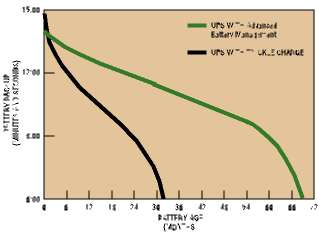Uninterruptible power supplies meet changing demands
Hardware and software advances make the newest products smarter and more reliable
BY SUSAN CONNELL
Deltec Electronics Corp.
San Diego, CA
Uninterruptible power supplies are no longer just considered batteries in a box. With features such as advanced charging schemes, improved topologies, and powerful software, today's uninterruptible power supplies are smarter, more reliable, and more flexible in meeting demands for correcting and managing bad power.
The PC and server markets are driving many of these changes. In PCs, volt-ampere ratings are slightly lower than before, thanks to more powerful internal power supplies and the use of power-reduction features. By contrast, in servers, volt-ampere levels are climbing higher as server clusters continue to replace mainframes. Moreover, internetworking equipment such as hubs and routers also require UPS protection.
Line-interactive UPS grow in popularity
As in the past, today's UPS can have an off-line, on-line, or line-interactive inverter configuration. Up to now, an on-line UPS was the choice for protecting sensitive electronic and computer equipment due to the absence of transfer time and good noise protection and power conditioning characteristics.
Today, however, line-interactive systems have become extremely popular because of their reliability, fast transfer times, power conditioning, surge suppression, and price. Newer line-interactive systems have tighter voltage regulation and battery management. One manufacturer, for example, uses a buck and double-boost voltage regulator that corrects input voltage variations from as low as 35% to as high as +20% of nominal voltage. This wide input reduces battery drain and adds more backup time.
On-line systems remain practical where unstable frequency may be a problem, such as in motor generator applications. But for most applications, the enhanced line-interactive systems are the cost-effective choice.
Battery considerations
Because of their typical 3 to 4-year life span and absence of a memory effect, sealed lead-acid batteries remain the standard choice for providing battery backup in uninterruptible power supplies. Technologies such as nickel-metal hydride are still too expensive for uninterruptible power supplies.
To maximize battery life, a recently developed technique called Advanced Battery Management (ABM) has emerged. This patented, microprocessor-controlled charging process doubles the life of the UPS batteries (see Fig. 1 ). In addition, it provides the fastest safe recharge time and reliable advanced notice when the batteries need replacement. A number of UPS manufacturers use this process in their supplies.
Fig. 1. The Advanced Battery Management charging process doubles the life of the UPS batteries.
The Advanced Battery Management process has the following stages:
1. Charge. A rapid constant-current charger brings the battery to near full capacity in three hours, compared to the 15 or more hours needed by other uninterruptible power supplies.
2. Float. A constant-voltage charge of 2.3 V/cell, similar to that used in other uninterruptible power supplies, continues for approximately 48 hours or until the batteries are solidly topped off.
3. Rest. At this point, the charger is turned off.
The charger is turned on again only when open-cell voltage drops below a set level due to use or to natural decay during extended periods of nonuse. Thus, a UPS that uses Advanced Battery Management typically requires charging of just a few minutes a day, compared to a non-ABM-equipped UPS that relies on a constant trickle charge.
Software enhances UPS performance
Software often has a role in improving UPS performance. Sophisticated power management software can indicate exactly what's going on with the UPS and standalone computer or entire network. This software automatically shuts down all connected devices in a predefined logical order and saves all work in process.
The software enables users to test and monitor uninterruptible power supplies on a network remotely as well as page and e-mail messages in the event of a power failure.
Other trends
A few manufacturers have recently developed an integrated hardware/software solution to prolong UPS up-time by programmable load scheduling. Users can now use power management software to determine which devices receive more battery run time during a power failure. For example, a server could be plugged into power receptacle 1 and the workstation into receptacle 2. Through the software, the user can program receptacle 2 to shut down in 3 min, adding backup time for the more critical server (see Fig. 2 ).
Fig. 2. Users can now employ power management software to determine which devices receive more battery run-time during a power failure.
Another trend is the proliferation of rack-mountable uninterruptible power supplies. One reason for this increase is the need to provide backup power for racks of network communications equipment and telecommunications and electronic test and instrumentation systems. More small rack-mountable uninterruptible power supplies will continue to emerge.
Advertisement






